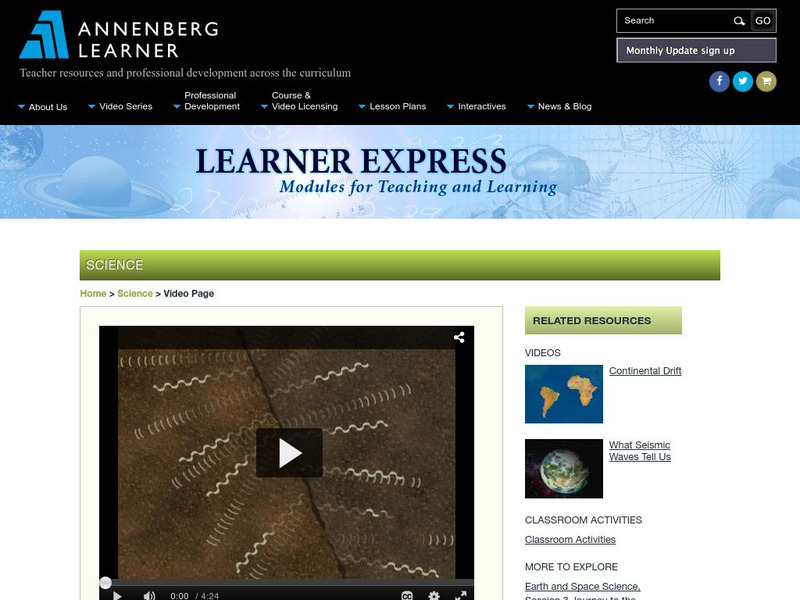Nature League
What is Biodiversity? - Lesson Plan
In this Nature League Lesson Plan, Brit explains the levels, dimensions, and values associated with biodiversity.
Wonderscape
Science Kids: Exploring Tectonic Plates and Earth's Landforms
This video is an educational lesson about tectonic plates and their movements. It explains the Continental Drift Theory and provides evidence to support it. The video also discusses the formation of tectonic plates, their movements at...
Nature League
What Are Adaptations? - Lesson Plan
In this Nature League Lesson Plan, Brit discusses physical and behavioral adaptations of life on Earth and shares some of her favorites.
Visual Learning Systems
The Theory of Continental Drift
The video discusses the theory of continental drift proposed by Alfred Vagner in 1912. The video explores the evidence that Vagner compiled to support his theory, including the geographic fit of the continents, fossil evidence, and rock...
Bozeman Science
Ecosystem Change
Climate change has happened throughout the history of the planet, and the video uses examples from continental drift to modern airplanes as measurable examples. It begins with how climate change will impact systems on the...
Howard Hughes Medical Institute
Continental Movement Over the Past 200 Million Years
Go for a ride on the continental drift. A video animation shows the movement of land over a period of 200 million years. The lesson instructor explains the shift during the animation and gives pupils a unique viewing perspective to...
Howard Hughes Medical Institute
Daly's Model of Subduction
The subduction model: helping learners understand how continental drift is possible. An animation demonstration illustrates the process of subduction through an analysis of the earth's layers. The instructor narrates the process as the...
Howard Hughes Medical Institute
Holmes' Model of Convection
Convection currents do more than just bake a cake. A quick lesson demonstrates the convection currents of the earth and how they contribute to continental drift. An animation illustrates the movement of the currents and demonstrates how...
PBS
The Whole Saga of the Supercontinents
See the world as it was—and also how it will be! A riveting video from a vast biology and earth science playlist takes viewers back in time to see how supercontinents formed, broke apart, and formed again. The resource includes a sneak...
Be Smart
How Do We Know Plate Tectonics Is Real?
Continents are on the move! An engaging lesson explains the acceptance of the idea of continental drift. The narrator of the It's Okay to Be Smart "Earth Science Videos!" installment considers the convincing evidence of the...
FuseSchool
Formation of New Species by Speciation
Why is Australia home to the world's only population of kangaroos? The answer? Speciation! Biology scholars discover the factors that cause new species to emerge through an engaging video as part of a Fuse School playlist on...
Channel Islands Film
Rotation
Travel along with the Channel Island as they drift from San Diego northward to their current location off the Coast of Santa Barbara. Dr. Tanya Atwater, a geophysicist and marine geologist at the University of California, Santa Barbara...
SciShow
Great Minds: Alfred Wegener
The first person to theorize continental drift was a meteorologist with a PhD in astronomy. Alfred Wegener was generally mocked at for his continental drift theory, but later science would prove him right. The video discusses his...
TED-Ed
What Happens When Continents Collide?
Ever heard of the Great American Biotic Interchange? The joining of North and South America caused one of the greatest biological migrations in Earth's history. Watch the continents collide and learn about the global consequences.
TED-Ed
The Pangaea Pop-up
The amazing animation for a video on continental drift is comprised of the pages of a sophisticated pop-up book, The Moving Earth. As the pages turn, your earth scientists discover the tectonic plates of the lithosphere and the...
Curated OER
Continental Drift
Playdough has reached a new level. This clay-motion video demonstrates continental drift, faults, volcanoes, and mountain formation. If you don't show this clip perhaps you could employ the concept and have your class make an amazing...
PBS
Pbs Learning Media: Plate Tectonics: Further Evidence
This video segment [2:12] adapted from A Science Odyssey uses animation and archival footage to provide an overview of the theory of plate tectonics.
Annenberg Foundation
Annenberg Learner: From Continental Drift to Tectonic Plates
A video discussing how the ocean floor provides evidence for plate movement. [4:23]
PBS
Pbs Learning Media: Plate Tectonics: An Introduction
This video segment adapted from Discovering Women uses animations to introduce the theory of plate tectonics and to explain why earthquakes occur and how continents form. 2m 21s
Khan Academy
Khan Academy: Plate Tectonics: Pangaea
Discusses the idea of Pangaea and some of the evidence behind its existence.
Bozeman Science
Bozeman Science: Ecosystem Change
Paul Andersen explains how ecosystems change over time. He starts by explaining how global climate change will impacts ecosystems around the planet. He then discusses how continental drift created climatic changes that impacted mammal...
Incorporated Research Institutions for Seismology
Iris: Gps Measures Deformation in Subduction Zone: Island Arc Setting
This animation shows that GPS can record the movement of the leading edge of the overlying continental plate in a subduction zone. [0:48]
Incorporated Research Institutions for Seismology
Iris: Continental Collision: India Asia
This animation shows a cut-globe view of the continental collision between India and Eurasia from 60 million years ago to the present. [0:06]


















